Welcome to Roger Russell's
History Page About
Haddon Clocks
These pages are copyrighted.
No portion of this site may be reproduced in whole or in part
without written permission of the author.
About This Page
After doing some research on Haddon, I have found that they made an overwhelming number of different clocks. I have selected only the few that I own or have information to put on this page. I have no further information at this time on these or other clocks that they made and I do not know their present day value.
About Repairs and Parts for These Clocks
I suspect it would be very difficult to find a reliable repair shop, either on the web or locally, that would want to or be able to make these repairs. I have been advised by the only repair shop I knew of that they have decided to stop doing repairs on these clocks. Some of them, such as the Home Sweet Home and Davy Crockett, are so cheaply made that there is no profit in the amount of time and effort needed to restore them. In other words, your cost for restoration could be way beyond what you would be willing to pay. The best place for parts is another clock of the same model that you might find on ebay.
What's On These Pages?
|
Haddon Mystery Clock Variations What Are Haddon Clocks Made Of? |
Haddon apparently went out of business many years ago. The building at 2066 S. Canalport Avenue is no longer there. Instead, the area is now a park. Haddon made several clocks that were similar to the Jefferson Golden Hour. However, a rotating gear in the rim drives the minute hand by means of a pin and the glass remains stationary. The hour hand is firmly attached to the glass and is driven through gears from the minute hand. The hour hand cannot be set independently, but must be set by turning the minute hand the appropriate number of revolutions. Because the minute hand must touch the rim, the illusion of the hands floating freely is not quite as convincing as the Jefferson designs. However, several models were lighted which Jefferson never accomplished.
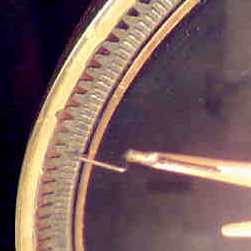 A patent number 2,843,999, found on several Haddon
clocks, was applied for on November 30, 1953 and was issued to Gordon R. Smyth
on July 22, 1958. It was assigned to Rubber Products, Inc. a corporation of
Illinois. The patent differs from the Prins rim drive
suggestion in that the minute hand can be easily turned in either direction to
set the clock. A short wire is attached to the end of the minute hand that
seats itself in the knurled valleys of the rim gear. This is found in the
Golden Vision, Golden Visionette and Commodore
A patent number 2,843,999, found on several Haddon
clocks, was applied for on November 30, 1953 and was issued to Gordon R. Smyth
on July 22, 1958. It was assigned to Rubber Products, Inc. a corporation of
Illinois. The patent differs from the Prins rim drive
suggestion in that the minute hand can be easily turned in either direction to
set the clock. A short wire is attached to the end of the minute hand that
seats itself in the knurled valleys of the rim gear. This is found in the
Golden Vision, Golden Visionette and Commodore
The left picture shows the rear of the ring from a Haddon Golden Visionette model 80. The short round wire can be seen engaging the serrations on the flat rear portion of the ring gear. The minute hand is pushed in slightly so that an outward spring action pushes the wire into the valleys. The large teeth to the left engage the motor gear at the bottom of the dial. A ring of gold paint on the back of the glass normally covers this view of the ring gear so that the gear and end of the wire cannot be seen. To set the time, the minute hand can be turned in either direction.
Another version of driving the minute hand has been found in a 1962 Haddon Sun Gold'n Hour clock. In this version shown at the right, there are no serrations on the back of the rim gear. There are only the teeth that engage the motor gear at the bottom of the dial.
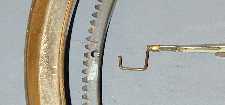 The hook engages a hole in the ring gear. I removed
the gear from the ring so it can be seen better. The minute hand is on its side
to show the hook arrangement at the end. This same construction is also found
in the Special Vision clock.
The hook engages a hole in the ring gear. I removed
the gear from the ring so it can be seen better. The minute hand is on its side
to show the hook arrangement at the end. This same construction is also found
in the Special Vision clock.
To set the time, the minute hand can only be turned clockwise. When setting the time, the entire outer ring turns as well as the output gear on the motor gearbox. A ratchet in the gearbox allows the gear to be turned only in the clockwise direction. The minute hand may need to be turned several revo;utions to set the correct hour and minutes.
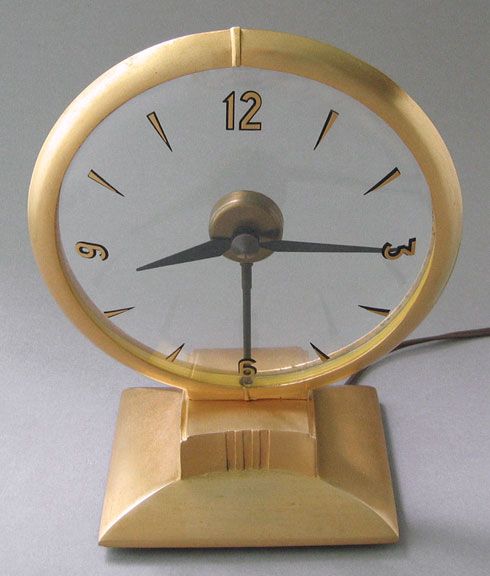
Model No. 500-U
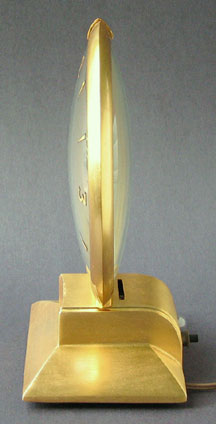 This clock appears to be better made than some of the
other Haddon clocks. Thick zinc die castings give a heavy feel to the clock and
the gold plating has an excellent luster. The hands are enclosed with curved
convex glass in the front and back. The hands are driven by a shaft in a round
tube that goes to the motor in the base. The tube can be seen at the numeral 6.
Gold numerals are at 3, 6, 9, and 12 o'clock. The other hours have gold
triangular shapes. They both have a black border. The hands and tube are black.
The dial is 7-3/4" in diameter and 1-1/2" thick at the center. The
overall height is 10-1/8". The base is 2-3/8" high (including feet),
5-7/8" wide and 5" deep (including the light switch knob).
This clock appears to be better made than some of the
other Haddon clocks. Thick zinc die castings give a heavy feel to the clock and
the gold plating has an excellent luster. The hands are enclosed with curved
convex glass in the front and back. The hands are driven by a shaft in a round
tube that goes to the motor in the base. The tube can be seen at the numeral 6.
Gold numerals are at 3, 6, 9, and 12 o'clock. The other hours have gold
triangular shapes. They both have a black border. The hands and tube are black.
The dial is 7-3/4" in diameter and 1-1/2" thick at the center. The
overall height is 10-1/8". The base is 2-3/8" high (including feet),
5-7/8" wide and 5" deep (including the light switch knob).
The clock operates on 110V 60 Cy A.C. and current of only, 9 watts. It has a Synchron model 610 1-rpm 3-watt motor. The output gear of the motor turns a larger gear connected to the shaft that goes to the hands. A 1/2" knurled knob underneath is used to set the time. Weight is 3.2 lbs. There is no underwriter seal on the bottom cover but there is one on the motor.

A light is in the bottom rear of the base along with a switch to turn it on and off. The end of the light bulb protrudes from a circular hole and can shine against a wall giving excellent illumination. A slot in the top of the base behind the dial is 1-1/2" wide by 1/8". It may help to ventilate the light and motor as no significant light comes from it.
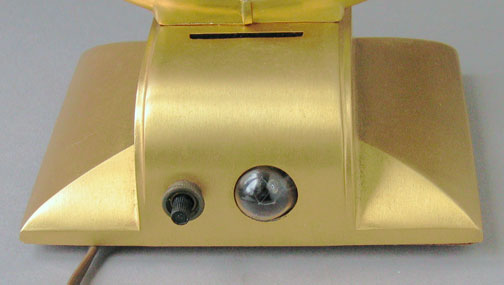
Instructions on the bottom cover are as follows:
To change bulb (and or) remove motor: Unscrew 2 back screws. With front of clock facing you, slide back slightly to right and then up to free bulb. To remove motor unscrew 3 red screws only with motor wires to your left move motor to right only and lift gently. To replace, reverse procedure, careful that wires do not interfere with motor. When back is in place, end of bulb should fit flush into opening.
Check for Bad Wiring
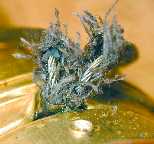 It's always good to check the wiring in these old
clocks before using them. The most obvious place is the line cord that can be
cracked and the wires can touch each other and cause a short circuit. This is
particularly true near the plug or where the cord enters the base.
It's always good to check the wiring in these old
clocks before using them. The most obvious place is the line cord that can be
cracked and the wires can touch each other and cause a short circuit. This is
particularly true near the plug or where the cord enters the base.
However, another place is inside the base and is not so obvious. Here is a close-up of the wires as they enter the Synchron motor in this 1954 Lighted Hour. The rubber appears to have cracked and fallen away, perhaps from the heat of the lamp. The cloth that covers it has come apart. This is a short circuit and a possible fire just waiting to happen.
![]()
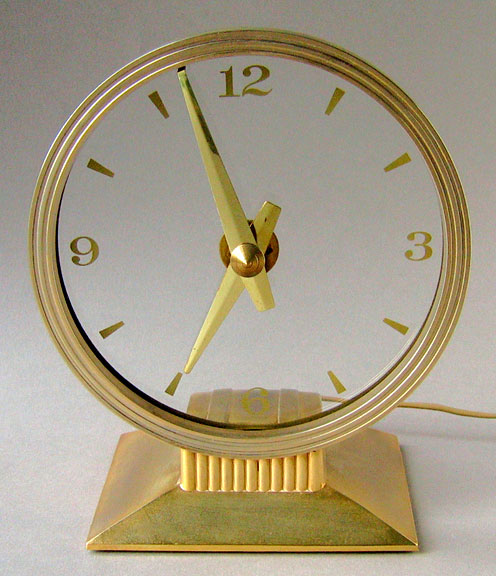
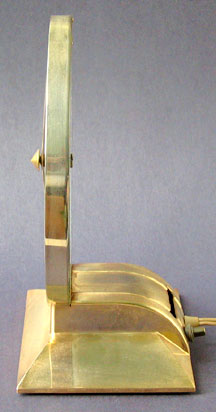 There's no identification at all on this clock, not
even a date. It has a shiny 24K gold plated finish that has been coated with
lacquer. On the face, numbers indicate the hours of 3, 6, 9, and 12 o'clock and
tapered rectangles indicate the remaining hours. These may have been screened
on with gold paint on the back of the glass. They are not deep etched and
filled with gold paint like some of the other models.
There's no identification at all on this clock, not
even a date. It has a shiny 24K gold plated finish that has been coated with
lacquer. On the face, numbers indicate the hours of 3, 6, 9, and 12 o'clock and
tapered rectangles indicate the remaining hours. These may have been screened
on with gold paint on the back of the glass. They are not deep etched and
filled with gold paint like some of the other models.
A synchronous motor is located in the base. The glass remains stationary and the motor drives a large gear in the outer ring of the clock. A hook attached to the minute hand engages the teeth in the gear. This drives the minute hand, which then drives the hour hand through gears at the center of the dial.
To set the time, the minute hand can only be turned clockwise. When setting the time, the entire outer ring turns as well as the output gear on the motor gearbox. A ratchet in the gearbox allows the gear to be turned only in the clockwise direction. The minute hand may need to be turned several times to set the correct hour and minutes.
There is a light in the base and a switch for it at the back. There is an opening in the rear of the base 1-13/16" wide by 5/16" high. A second opening is in the cardboard bottom cover that is 1-5/8" by 1/4". The light can shine above and below the clock so that it can be seen at night.
The clock face is 7-3/4" in diameter at the outside. The overall dimensions are 9-3/8" high, 7-3/4" wide and 5-1/8" deep including a switch handle. Weight is 2.34 lbs. Thanks to Jay Pine for confirming it was made by Haddon and for the model name.
The picture at the right is a Special Vision that was advertised in the Bennett Brothers, Inc. catalog in 1961. It is described as "Special Vision 'See thru' Mystery Glass Dial and 24k gold plated metal case. 8-1/4" x 7-3/4". Wt. 4 lbs. A Special Value. Angle Vision, gift packaged.....Electric.....Retail $19.95"
![]()
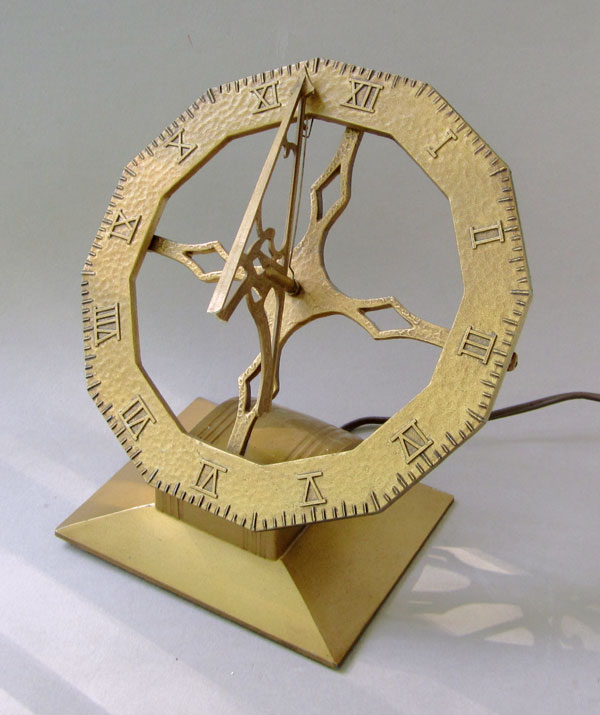
This very unusual clock is made like a sundial. There is no model number. The arrow at the end of the gnomon indicates both hours and minutes. Short lines between the roman numerals are at 5-minute intervals and longer lines are at 15 minute intervals. The dial face has 12 sides and is 8-5/16" between any two parallel sides. It angles back at 45 degrees. The dial, gear-housing ring, center spider and base are all made of cast metal. The overall height of the clock is 8" and overall depth is 6-7/8". The base is 6-1/8" wide and 4-11/16" deep. Power requirements are 110V.A.C. 60 CY only, 2.5 watts. A UL seal is on the maroon colored base plate. Weight is 3.3 lbs.
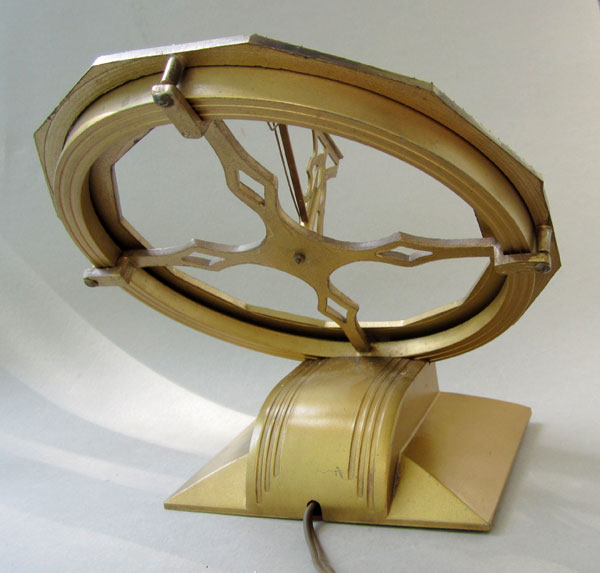
The face and the 4-prong spider in the rear are attached to each other with four screws and clamp the perimeter gear ring.
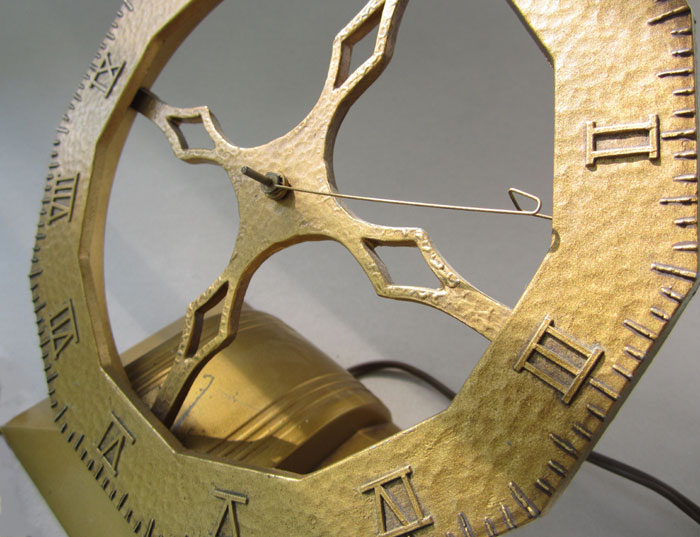
The plastic gnomon and a wire are mounted on a shaft in the center of the spider. The wire extends under the face to a gear in the perimeter of the dial. The gnomon/wire assembly can be easily turned so that the wire seats itself in the knurled valleys of the rim gear. The pointer end has a pin that engages the wire loop to hold it in place. The center pin holding the wire fits into a hole in the gnomon.
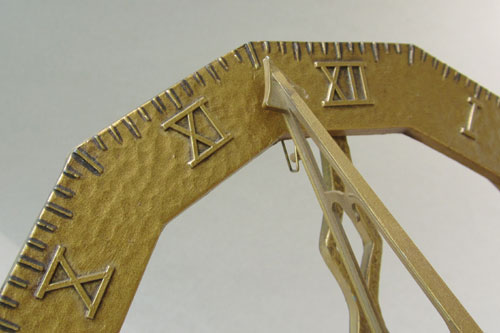
A piece is missing from the top of my gnomon.
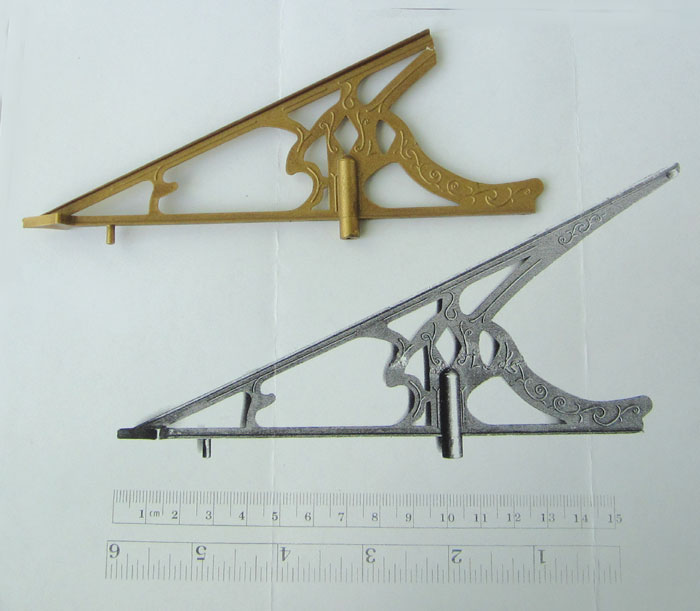
A reader of my page sent me a copy of what an undamaged gnomon should look like compared to mine.
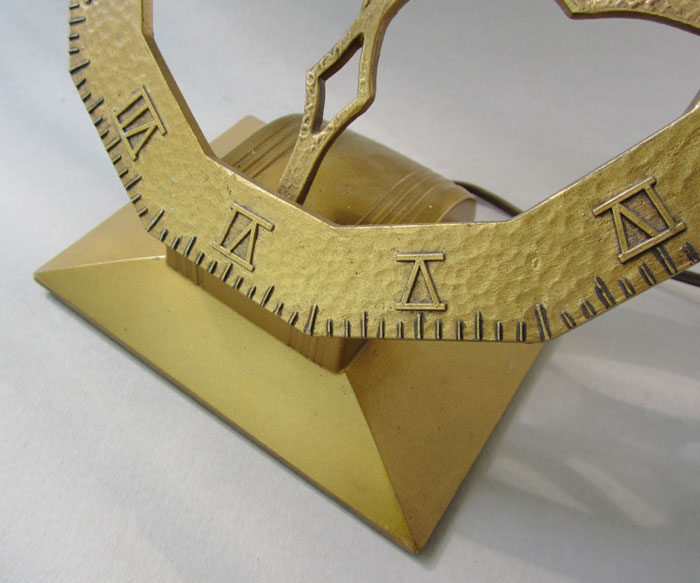
The base is very similar to several Jefferson Electric clocks.
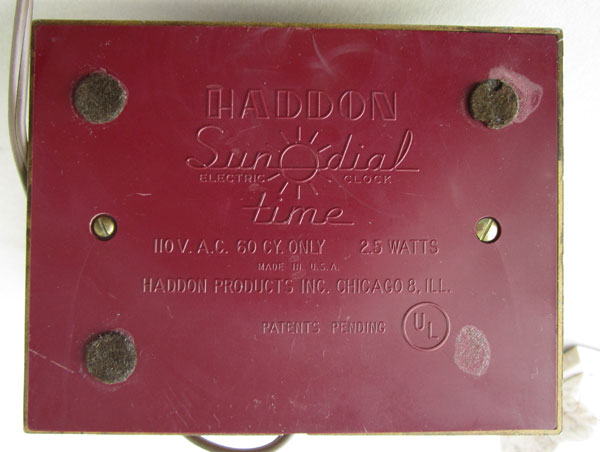
Bottom Plate
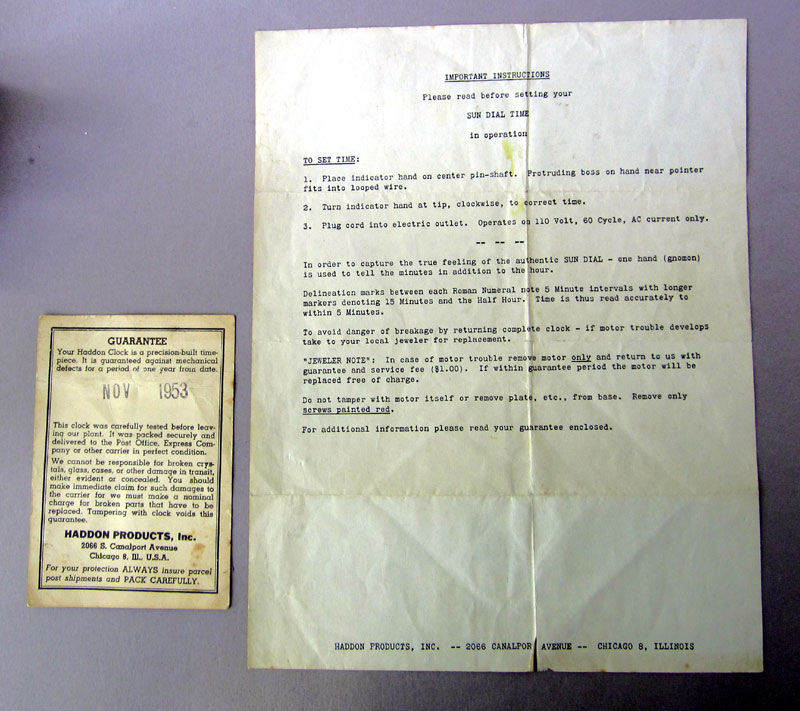
Date of manufacture for this clock is November 1953. An instruction sheet and a guarantee card came with the clock.
![]()
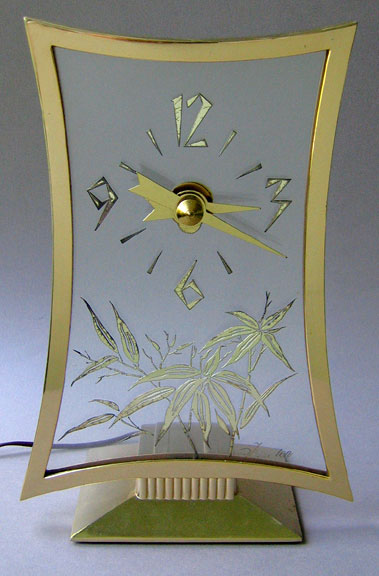
This is one of the most interesting clocks
that's on a par with the Mastercrafters Fantasy Model
209 mystery clock. It's definitely an oriental style and the base looks very
similar to the Mastercrafters clock. This clock has
two pieces of glass. The front one has the hands attached. The rear glass is
driven by a pin that slides slowly up and down each minute to drive the hands.
Thanks to Jay Pine for identifying the name of this clock. The clock in 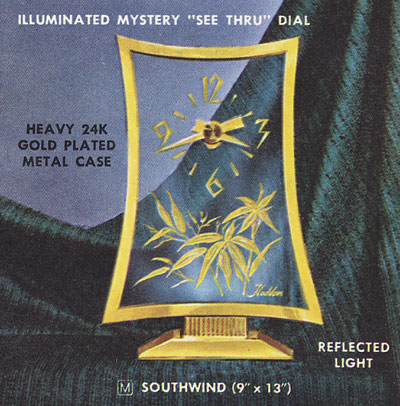 the picture was missing the base plate.
the picture was missing the base plate.
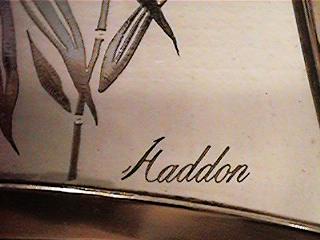 The designs on the glass are 24k gold painted,
including the name Haddon. This clock is also lighted. The date on the inside
is November 15, 1960
The designs on the glass are 24k gold painted,
including the name Haddon. This clock is also lighted. The date on the inside
is November 15, 1960
The Southwind (lfet picture) was advertised in the Bennett Brothers, Inc. catalog in 1961. It's described as "A new concept in design: its sweeping curved lines exacted a whole new idea in Time Keeping. Spell binding conversation (time) piece. 24k heavy gold plated metal base and rim. Deep etched and 24k gold filled. 3-dimensional time indicators and bamboo design, on "See-Thru" Mystery glass dial.
Reflected light controlled by concealed switch allows clock to be used as a night light or T.V. light.
9" W, 13" H, Wt. 5 lbs.
Electric Lighted, Retail $29.95"
![]()
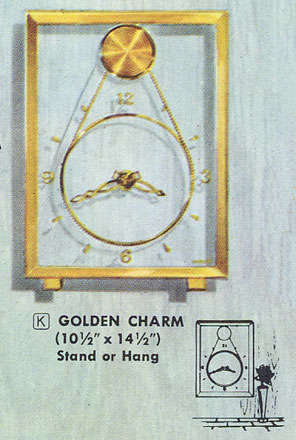 Here's a clock that looks like the Jefferson Suspense
but isn't quite so heavy. It can be used free standing or hung on the wall.
Here's a clock that looks like the Jefferson Suspense
but isn't quite so heavy. It can be used free standing or hung on the wall.
The Golden Charm was advertised in the Bennett Brothers, Inc. catalog in 1961. It's described as "See thru Mystery Glass Dial and 24K gold plated metal parts and golden bronze wooden frame. Stand or hang. (Includes feet).
10-1/2" X 14-1/2". Wt. 7 lbs.
A distinctive conversation (time) piece. Electric.
Retail $34.95
![]()
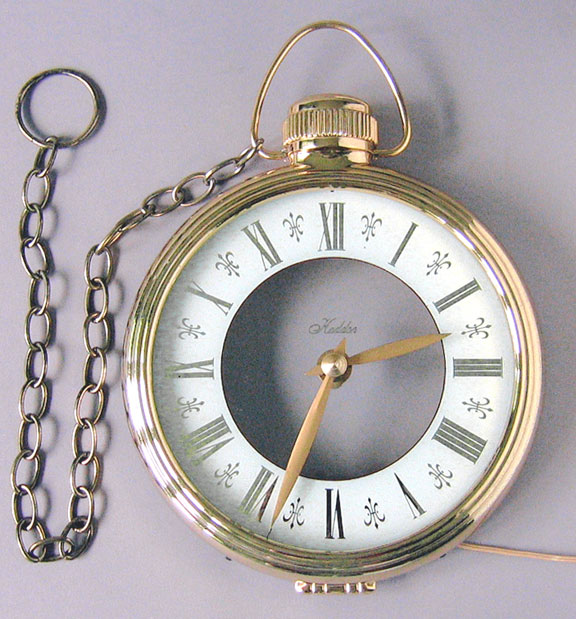
The Titan was another pocket watch style but was a wall hanging clock complete with chain. Roman numerals are used to indicate the hours and a decorative design is used in between the hours. It's 14" in diameter and is lighted.
The Kuppenheimer Clothes clock (left) was similar to the Titan but was used for advertising and was not lighted.
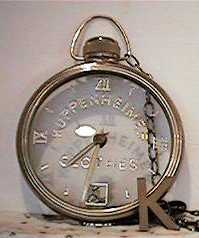 The Titan was advertised in the Bennett Brothers, Inc.
catalog in 1961. It's described as "Titan Illuminated Electric See-Thru
Mystery dial with mirrored gold time markers. 24K gold plated metal cast case.
Complete with polished brass chain.
The Titan was advertised in the Bennett Brothers, Inc.
catalog in 1961. It's described as "Titan Illuminated Electric See-Thru
Mystery dial with mirrored gold time markers. 24K gold plated metal cast case.
Complete with polished brass chain.
13" W., 17-1/2" H. Wt. 8 lbs.
Electric lighted
Retail $29.95"
Also advertused in the 1961 Bennett Brothers, Inc. catalog is the "Titan 8 Day or Battery: As above except solid ivory finished dial, no lights.
8 Day Retail......$31.95
Battery Retail...$37.95"
![]()
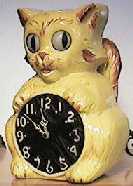 Model #50.This clock is very hard to find complete
with the tail. The tail is made of thin brittle plastic about 1/16" thick.
Two small brass eyelets are attached to the tail. They slip onto a U shaped
wire shown in the picture at the right. The wire is driven by the motor to give
a side-to-side motion. The Kitten can then be set on a shelf and the tail and
eyes move.
Model #50.This clock is very hard to find complete
with the tail. The tail is made of thin brittle plastic about 1/16" thick.
Two small brass eyelets are attached to the tail. They slip onto a U shaped
wire shown in the picture at the right. The wire is driven by the motor to give
a side-to-side motion. The Kitten can then be set on a shelf and the tail and
eyes move.
There is option for wall mounting. A second U shape in the wire faces down. The tail can be slipped onto the lower U shape and will hang below the kitten. The tail and eyes will move.
The wire is about 1/16" in diameter. Dimensions of the clock are 8-1/2" high, 6" wide and 3-1/4" deep. The tail is 5-3/8" long, 1-1/2" wide and 1/2" deep.
On the back it says "The versatile Kitten Clock Model #50. Operates on 110 volts 60cy AC current only, 3 watts. Made in USA Haddon Products Inc., Chicago, Ill."
A note near the upper loop of the wire says: "Slide eyelets of tail inside wire loop at this point if used as a sitting clock." A note near the lower loop says: "Slide eyelets of tail inside this point if used as a wall clock."
Thanks to David Grant for the pictures and information about this clock that is part if his collection.
![]()
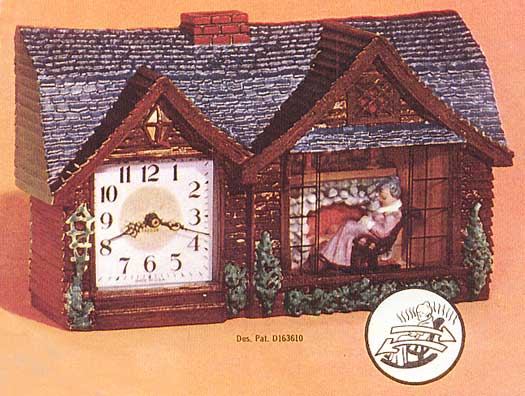
Here is a picture and text from an advertisement in a 1956 Keystone catalog.
The clock may have been made over a period of several years around this time.
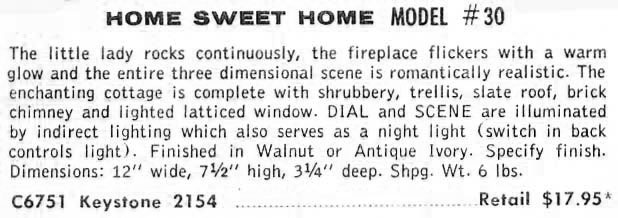
![]()
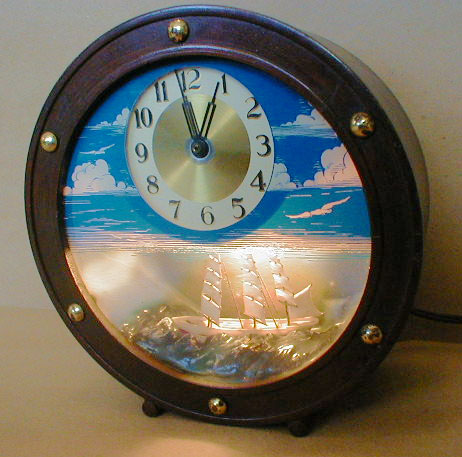
Here is text from an advertisement in a 1956 Keystone catalog.
The clock may have been made over a period of several years around this time.
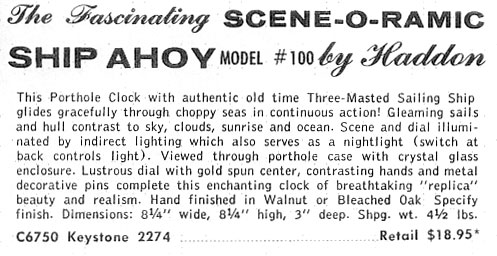
![]()
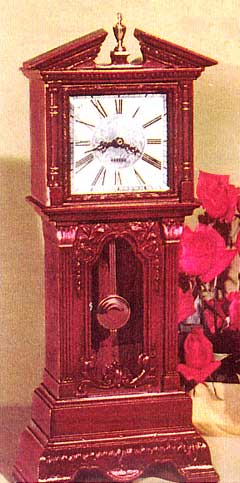
Here is a picture and text from an advertisement in a 1956 Keystone catalog.
The clock may have been made over a period of several years around this time.
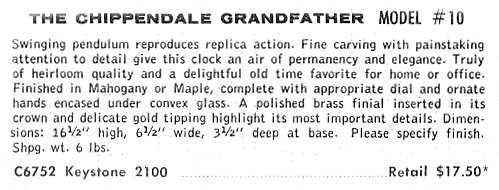
![]()
Microsoft uses Haddon in Advertising
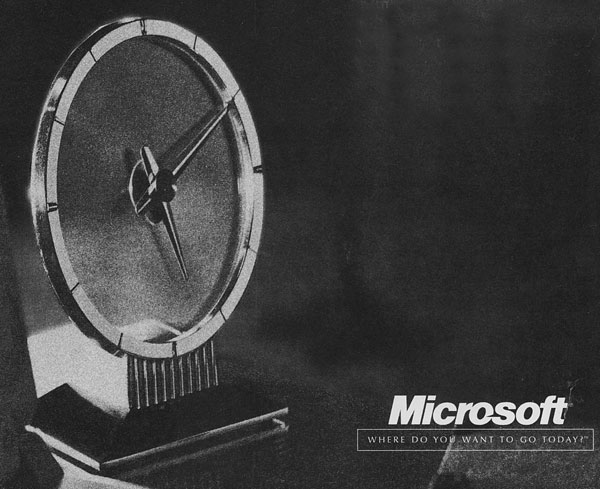
Microsoft had an 8-page brochure announcing the new Microsoft Windows 95 operating system. A mystery clock occupied a good portion of the front and back covers. Here is a partial picture of the back cover. At first glance one might think this was a clock catalog instead of a Windows advertisement. No mention was made of the clock. This was a Haddon Sun Gold'n Hour electric clock and is not to be confused with a Jefferson Golden Hour. Features identifying the Sun Gold'n Hour are lines with no numbers on the outer ring, the face tilted back slightly and the minute hand extends to the rim where a wire connects to the ring gear.
It is plain to see in the bedroom scene there is a mystery clock. It has numbers on the glass face so it is not a Jefferson clock. It stands vertically so it is not a Golden Vision and it is large so it is not a Golden Visionette. So it is probably a Special Vision.
The movie is A Fine Madness with Sean Connery and Joanne Woodward from 1966.
Additions are welcome.
![]()
Other Clock pages I have created
|
A history of the Jefferson Electric Company including many mystery clocks and other products they made. Lots of pictures and text. |
|
Other pages I have created and personal information. |
|
|
Sorry, I don't know the present value of these clocks. See top of this page. |
More text and pictures about Haddon will be added as my research continues. Any comments, corrections, or additions are welcome. |